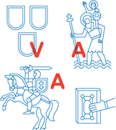Prof. Deimantas Narkevičius’s group
The main goal of this course is to aid the studying person, through horizontal communication, in finding their method of self-growth, which would steadily transform into autonomous artistic work. Formally speaking, a student in a higher education school of arts is an artist, therefore as they are studying, they already chose their speciality and must learn to formulate tasks for themselves, and to clearly express their intentions. In other words, to formulate ideas and to be able to explain them, and to purposefully make use of the required research material. The object created by the student is only as valuable as the creator is able to substantiate it, operating both on their personal experience and the essential principles (concepts) of artistic practice, formulated over the span of art history, hopefully discovering discourses that are novel to at least themselves. The student must critically assess, recognise and determine the origins of the prevailing artistic concepts, as well as their possible interpretations in both professional, and wider sociocultural contexts. It is desirable that the student is communicative, and able to successfully present themselves in both internal and external art scenes. The study period should be a time for getting to know the development of art in the past decades, as well as for adequately evaluating one’s personal abilities in this context. This would become the basis for the formation of authenticity, which would later help take on the psychological barrier at the time when the artist is not yet associated with long-term projects, does not ‘belong’ to commercial galleries or creative unions, and is not included in any other long-term collaboration with art institutions. The academic environment is a sufficient institutional background to begin a creative practice and the student should make effective use of it, understanding that such is the established international convention - an inevitable stage of their career. Art studies are in the interest of the student themselves. D. Narkevičius’s concept of subject and object could metaphorically be compared to a director creating a film. To implement the written screenplay, all available means are employed to create an appealing image in each frame. Thus, the succession of frames, accompanied by the soundtrack, creates the illusion of a lateral time flow, a sense of perspective, a three-dimensional characteristic. The field of view is like a secondary, cinematic reality, is an environment that is manipulated, made audible, and is otherwise affected in its totality, and the reasons behind it are the internal processes in the author’s consciousness, as well as their experiences. These micro movements become the images of the artist’s intention, as successful as the artist is capable of giving a form to them. Deimantas Narkevičius has held 47 solo exhibitions, the largest of which was at the National Reina Sofia museum in Madrid in 2008, he has also participated in 120 group exhibitions, including the Venice, Istanbul and San Paulo biennales, Münster Sculpture Projects ‘07, and exhibitions in the New Museum in New York and Pompidou Centre in Paris. 28 large private and national collections have purchased Narkevičius’s works, including MoMa in New York, Tate Modern in London, and the French National Collection. D. Narkevičius is represented by gb agency, Jam Mot, Barbara Weiss galleries.



